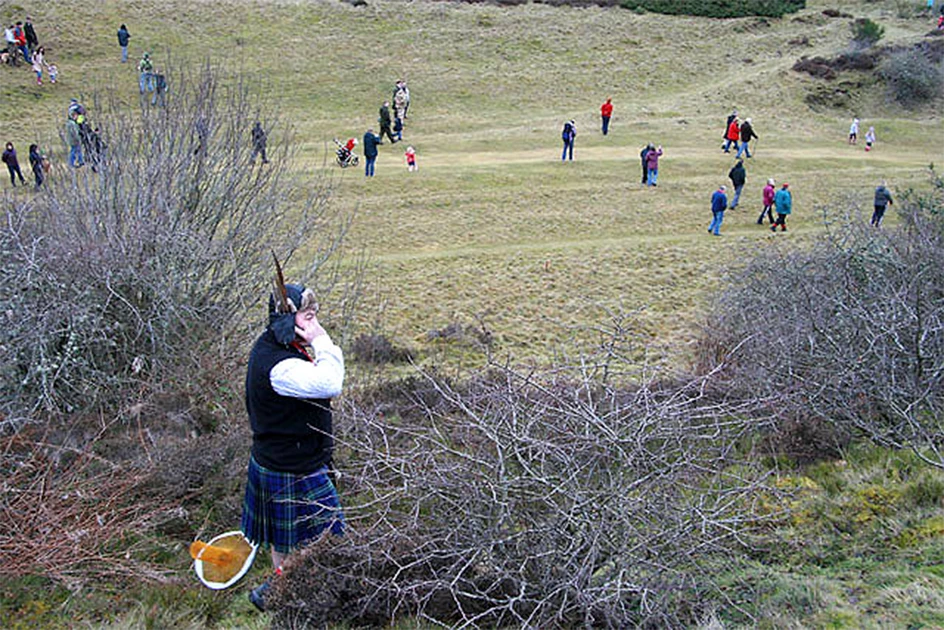There has been a strange theory that has crept out from Scotland about the wild haggis and haggis hunting. Haggis: a dish made from the heart, lungs and liver of a sheep (it’s delicious) wrapped up in its stomach (we promise, really tasty) is synonymous with Scottish cuisine.
However, it would seem that there is still a great deal of uncertainty out there as to what exactly Haggis is. Unfortunately, the mythical stories are not true, and in all honesty are not that old, either.
Haggis is the fatty caul of a sheep, filled with oatmeal and spiced innards, boiled, baked and traditionally served on Burns night. This is a memorable occasion, as anyone who has attended such an event and had a drunken Scotsman (whisky is mandatory) wave a sword at them while he slurs his way through a Burns poem will attest.
There are other stories, however. Some would have you believe that the wild haggis is an unbalanced beast that has legs of unequal length to help it gallop across the steep Scottish hillsides. There is even a display of one in the Kelvingrove Art Museum found in Glasgow.
It is depicted as a shaggy, short-legged animal and labeled as Haggis Scoticus in Latin. Despite all of this, it is definitely a myth. But here is how this myth has survived and developed.
The Haggis Beast
Whilst it is not clear where the myth originally came from; it belongs alongside the other fake animals such as the drop bears or jackalopes all of which were used to try and lure tourists. One of the earliest mentions that exist of the wild haggis comes from the New York Tribune from 1924.

The satirical journalist and poet, James J. Montague wrote a poem which discussed a hunt for the mythical creature:
“My heart’s in the Highlands, twa strings on my bow
To hunt the fierce haggis, man’s awfu’est foe.
And weel may my bairn ha’ a tear in his ee.
For I shallna come back if the haggis hunts me.”
- Dressed to Kilt: Is Tartan an Ancient Tradition or Modern Invention?
- Felines in the Moat? The Great Washing of the Lions Hoax
For whatever reason, these words seem to have stuck. In 2003, a company that sold haggis surveyed 1,000 American visitors to Scotland and claimed that the results were that a third of Americans believed in the mythical haggis.
This is not a joke that has ended recently either. The Visit Scotland website joked in 2014 that they had footage of the extremely rare “swift haggis”. A visitor to many a tourist shop in Scotland can purchase stuffed animals and a haggis summoning whistle to help them on their hunt. But it is unlikely that they will follow the whistle.
Despite its origin in myth, haggis hurling has become a popular sport in Scotland that involves the tossing of haggis as far and as accurately as possible. Despite the organizer’s claims for an ancient origin, haggis hurling was actually only invented in 1977.
Robin Dunseath, a publicist for Tom Farmer, a Scottish entrepreneur claimed in 2004 that he invented the sport in 1977 at a Gathering of the Clans in Edinburgh. Dunseath claims that he did this as a practical joke and wanted to use the sport as a way to raise funds for a charity at Highland games.
It featured on a BBC TV program called That’s Life which revealed the whole thing was a joke. However, despite this, two variations developed: one as a sport and one performed at festivals.
At present the world record for haggis hurling is a distance of 217 feet, or 66 meters. It was set by Lorne Coltart in June 2011 at the Milngavie Highland games in which it beat the previous records set by Allan Pettigrew nearly 20 years before.
Not only that, it destroyed the previous record which was only 180 feet or 55 meters. There has been a rumor that Tom Moody, the Australian cricket player set a record of 230 feet or 70 meters in 1989, but sadly there is no official confirmation of this.

In the modern haggis hurling competition, the throwing is judged on distance and accuracy and ensuring that the haggis does not split or burst when it lands. The rule is that the haggis needs to be fit for eating after it has landed.
The sport thus requires a more subtle technique rather than just throwing the haggis as far as you can. The hurl must result in a gentle landing so that the haggis skin is intact.
- The Beast of Glamis Castle: A 200 Year Old Royal Monster?
- A Dangerous Game: Why was Medieval Football Banned?
The rules of the competition are fairly easy. The haggis must be made traditionally made from a boiled sheep’s heart, lung, and liver with onions, spices, oatmeal, and suet. All of this is stuffed in a sheep’s paunch and boiled for three hours.
When the haggis is thrown it needs to have been cooled and inspected so that it is clear no firming agents have been used. The haggis is packed tight and secure so that no flab and extra skin.
There are two kinds of Haggis that can be used. A sporting haggis weighs around 500 grams (17.5 ounces) and can be no larger than 18 cm (7 inches) in diameter and a length of 22 cm (8.5 inches). There is an allowance of 30 grams (1 ounce). However, a heavyweight haggis can also be used, going up to 1 kg (2.2 lb) in weight with an allowance of 50 grams (1.7 ounces).
Haggis Hunting
Even despite the haggis animal being clearly mythical, so-called experts have come up with top tips for hunting haggis. One guide claims that the most effective and humane way of catching a haggis requires a shovel, black pepper, a tape measure, sticks, and leaves.

Haggis has no prime hunting season and so one can hunt them whenever the weather suits them. Haggis are small creatures that are easily missed and difficult to spot, but they are said to love the smell of pepper. In order to catch one, it is advised that a person’s scent is also masked by dabbing whisky on themselves.
To trap a wild haggis, a shovel is used to dig a hole around a foot wide. It does not need to be too deep, around 15 cm (6 inches) will do. Line the hole with leaves so that the haggis is protected when it falls in.
In order to attract the haggis, place pepper in the hole and cover it with sticks and then more leaves. It is important not to cover the pepper completely though otherwise the haggis will not be able to smell them.
If a hunter wants to ensure that a haggis will arrive it is imperative that they then squeal like a haggis. A simple howl should do the trick to attract a prime haggis. Probably.
Top Image: Great chieftain of the pudding race: a wild haggis, currently on display in Glasgow. Source: StaraBlazkova / CC BY-SA 4.0.
By Kurt Readman